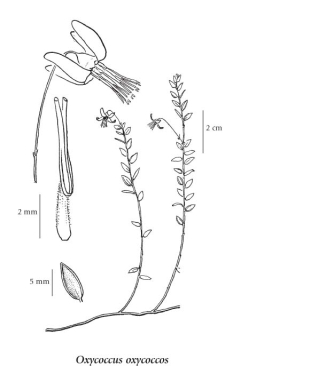Vaccinium oxycoccos L.
bog cranberry
Ericaceae (Crowberry family)
Introduction to Vascular Plants
bog cranberry
Ericaceae (Crowberry family)
Introduction to Vascular Plants
Photograph
© David Blevins (Photo ID #509)
Species Information
General:
Small, creeping shrub; stems very slender, 15-50 cm long, 0.2-1 mm thick, glabrous to finely hairy.
Leaves:
Evergreen, alternate, leathery, egg- to lance-shaped, tapering to tip, 2-10 mm long, 1-5 mm wide, deep green and shining on the upper surface, greyish beneath, margins rolled under.
Flowers:
In apparently terminal clusters of 1 to several, or sometimes lateral; flower stalks very slender, 2-5 cm long, glabrous or finely hairy, curved downward near summit at flowering, erect in fruit, with 2 bracts, 1-2.5 mm long, usually below midlength of the stalk; corollas deep pink, of 4 distinct petals, oblong to oblong-lanceolate, 5-8 mm long, curved back; calyx lobes 4, less than 1 mm long; stamens 8, filaments hairy on margins and at least half as long as the anthers; anthers unawned, with terminal tubes.
Fruits:
Berries, 5-12 mm wide, pale-pink to deep red.
Notes:
Some authors split this taxon into two or more species. Recent studies suggest that this is unwarranted (Vander Kloet 1983). Although sometimes considered part of the genus Vaccinium, Oxycoccus is treated separately here (as in many other floras). The flowers of Oxycoccus are 4-merous and the corollas are deeply parted, with only the base being joined. In contrast, the corollas of Vaccinium are united and generally only toothed or undulating at the summit. The differences in the flowers and growth habit seem to justify the separation.
Illustration

If more than one illustration is available for a species (e.g., separate illustrations were provided for two subspecies) then links to the separate images will be provided below. Note that individual subspecies or varietal illustrations are not always available.
Illustration Source: The Illustrated Flora of British Columbia
Habitat and Range
Bogs in the lowland and montane zones; frequent throughout BC; circumboreal, N to AK, YT, and NT, E to NB and NS, and S to OR, ID, and MN; Eurasia.Status Information
Synonyms
Synonyms and Alternate Names:
Oxycoccus oxycoccos (Linnaeus) MacMillan